Types Models of Communication in Business there is no single communication model that contains all the elements of a specific communication situation. The communication theorists (Specialists) have developed different communication models till date. Some of the important communication models are discussed below:
- Aristotle’s persuasion Model
- Newcomb’s Inter-Personal Communication Model
- Hoveland’s Persuasion Model
- Thayer’s Organizational Communication Model
- Shanon and Weaver’s Informational Theory Model
- Collin and Guetzkowr’s Group Communication Model
- Circular Model of Communication
- Interactional Model of Communication
- Berlo’s S-M-C-R model
- Modern Model of Communication
The above mentioned communication models are elaborately discussed in the following pages in successive way.
Types Models of Communication
Aristotle’s Persuasion Model: The Business Communication model produced by Greek Philosopher Aristotle is popularly known as the “Aristotle’s Persuasion Model”. According to him, “When any political leader or a teacher delivers his speech in gathering and in class-room respectively, their style of speech is included in persuasion model”. The model is shown below:

In this model, three elements of Business Communication Process have been detected. There is no scope of responding by the receiver and his role is neglected here. This model is considered as a one sided Business Communication Model.
Newcomb’s Inter-Personal Communication Model: This is one of the simplest models of Business Communication. In this model, there are three parties to effective the Communication Process. According to Newcomb, “There might be a third party between the sender and the receiver and that third party can manipulate the Communication Process.” The model is shown below:
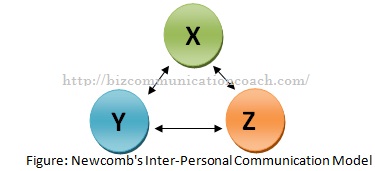
In the figure, there are three parties X, Y and Z and if any two parties want to communicate with each other, they must depend on the third party and the third party can influence the Business Communication Process. This communication Model does not present all the elements of Business Communication Process, even the sender and the receiver are not identified here.
Hoveland’s Persuasion Model: This Model is almost same as the Aristotle’s Persuasion Model but this basic deference between them is that in this model the audience stays in a certain place and hears the speech and the feedback of the audience’s response is returned to the speaker. The model is shown below:
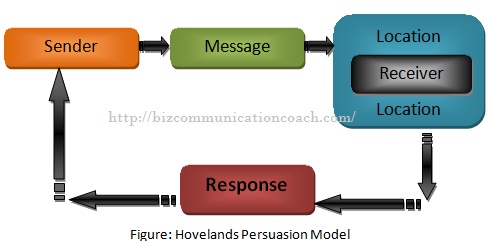
Thayer’s organizational Communication Model: This model creates a link between personal Business Communication and organizational structure. In his model, Thayer has shown that the attempt to accomplish any task through personal communication greatly influences the process of organizational communication. The model is shown below:
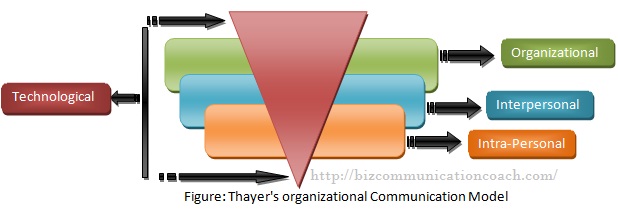
Thayer has mentioned four levels in this Business Communication Model, such as-intra-personal or individual, interpersonal, organizational and technological. This model also shows how a person’s does communication functions in organizational level. The behavior of sender and receiver can be influenced by four elements biological, psychological, social and technological. Actually, this model shows how communication process is affected by a person in organizational atmosphere.
Types Models of Communication in Business
Shanon and Weaver’s Information Theory Model: This model shows that the communication process begins from the brain of the sender. The sender moulds his thought, concept or ideas into message and sends to the receiver. Then the message goes to the receiver through certain media and his brain receives it. After the message being perceived, the reaction of the receiver is sent back to the source of the message (Sender). The model also includes a transmitter that converts the message info perceivable signal. The whole process can be interrupted by noise. The model is shown below:
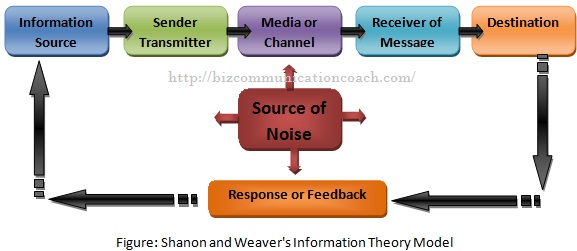
This Model is one of the most comprehensive models of communication as it includes feedback and it is very close to the modern model of Business Communication.
Collin and Guetzkowr’s Group Communication Model: This model analyzes the decision making process or communication in small and big or large groups. The group communication is almost same as organizational communication. The model is shown below:

From the figure, it is clear that the above three boxes indicate sources of problem, group behavior and reward of work environment and the three boxes below indicate sources of pubic behavior, interpersonal behavior and interpersonal reward. In every group communication, this process is active and environmental barriers in workplace and interpersonal environmental barriers largely impact on the group communication behavior.
Circular Model of Communication: In real sense Business Communication is a Two Way Process where the sender sends the message to the receiver and after receiving the message, the receiver sends feedback to the sender. The success of Business Communication Process largely depends on the reaction or response or feedback of the receiver. The circular model of communication emphasizes on the feedback system of communication. The model is presented below:
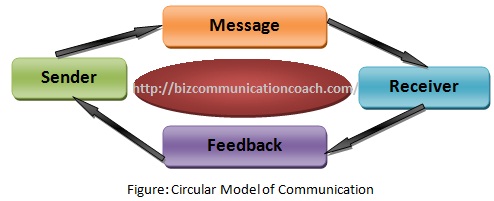
The circular model of Business Communication is an important communication model where greater importance has been given on the feedback of the receiver which is vitally important for effective Two Way Communication.
Interactional Model of Communication: Tubbs and Moss have developed the interactional model of Business Communication. This model shows the communication process as an exchange process of message between the parties. The model is shown below:

The figure shows that person X (Sender) sends a message to person Y (Receiver). Y becomes the sender when he sends response to X, who becomes the receiver this time. This process will be continued until the desired result of the parties is achieved. This is Two Way Business Communication Model.
Berlo’s S-M-C-R Model: The S-M-C-R model of Business Communication was developed by David K. Berlo in 1960. Where S stands for source, M for message, C for Channel and R for receiver. The model is shown below:

The model shows that the source (Sender) transmits the message to the receiver through some channel. It also indicates that both the sender (Source) and the receiver are influenced by their own culture, social system, knowledge, attitudes, communication skills and other factors. Though this model doesn’t emphasize on feedback, it is a comprehensive model, because it shows how the sender and the receiver can be influenced by various factors that may also act as the sources of noise.
The Modern Model of Communication: Over the period of time Business Communication Process has been developed a lot. The communication theorists are still investing their endeavor to make the Business Communication system more compressive and conceivable by including important and new items or elements in it. The modern communication model has important and new items or elements in it. The Modern Communication model has evolved from Shanon and Weaver’s information Theory Model. The modern communication model is presented below:

Types Models of Communication in Business the Modern Business Communication Model includes nine elements and emphasizes duly on the feedback system. The figure shows that sender and receiver are the major parties in the communication process; message and media are the major communication tools, encoding, decoding, response and feedback are the major communication functions and the last element is noise that can create interruption at stage of the Business Communication Process.

Your article has been copied in a University book in India , everything is same . The books name is Reliable Series – F.Y.BCOM Business Communication Semester – 1 .